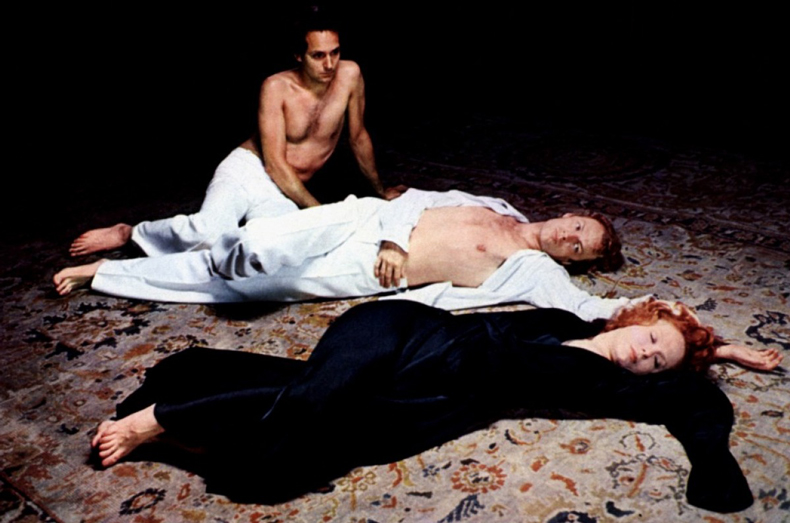‘This termination, this process of shutting down, has a name: film,’ Marguerite Duras wrote in 1977. ‘Film stands for this definitive ending.’ She was writing, as part of a press release for her film The Lorry (1977), about the ‘pointless’ enterprise of film-making, its tendency to inhibit the imagination. Such language is typical of Duras, a film-maker who frequently expressed her scepticism of the medium she did much to reinvent. In her avant-garde films, which often centre around a sense of identity in collapse, or sever the relationship between sound and image, the conventions of cinema are ruthlessly interred. The ICA’s major retrospective of Duras’s work, organised with the feminist film journal Another Gaze, is aptly titled ‘Let Cinema Go to Its Ruin’.
Born in 1914 in French Indochina (now Vietnam), Duras moved to Paris when she was 17. She became a prolific writer of fiction and plays after the Second World War, using clipped, rhythmic sentences to suggest forms of psychic estrangement and dissolution. Duras’s film-making was born in part from her writing, as she developed a highly productive method of self-adaptation. Her first script was for Alain Resnais’s Hiroshima mon amour (1959), based on her novel of the same name, and from there she repeatedly returned to and converted her own material for the screen. But Duras’s film-making was also born from what may have been writer’s block: the 1970s, when she made the majority of her films, also brought a spell of unusual literary reserve.

A still from Agatha and the Limitless Readings (1981), directed by Marguerite Duras. Courtesy the Institute of Contemporary Arts, London
Part of this turn towards cinema was, according to Duras, ‘to fill my time’. One suspects it also came from contempt. If Duras disputed the aesthetic capacities of cinema as a whole, she decidedly disdained commercial films, which ‘stunned into tranquillity’ the ‘sickly masses’ of the movie theatre and placated audiences by implicitly confirming dominant cultural values. (Duras was vociferously leftist, a soixante-huitarde who believed in a ‘feminine literature’.) As a result, her early films are austere anti-narratives, usually involving only a few characters in a single location who wreak emotional violence upon each other. Destroy, She Said (1969) features four guests in an empty hotel, who provoke each other into a kind of erotic group annihilation. ‘They’ll find you both melted into a shapeless lump like tar,’ Stein, one of the guests obsessed with the married Alissa, informs the couple, ‘and no one will understand but me.’ In these early films, individual identity – which, for many leftist intellectuals of the era, represented bourgeois and patriarchal ways of thinking – might be voided at any moment.
As the ’70s progressed, Duras went further with her refusal of political and aesthetic conventions, now rupturing the naturalistic relationship between sound and image. In Baxter, Vera Baxter (1977), a sprightly, endlessly looping soundtrack plays throughout with no regard for the content of each scene, as if the film itself is in the throes of possession. Even more audaciously, the mid-career masterpiece India Song (1975), a sensuous colonial drama about the many affairs of a French ambassador’s wife in Calcutta, doesn’t feature a single character speaking on-screen. Instead, as they languish amid the ennui of power and foiled desire, the suitors of Anne-Marie Stretter appear on the soundtrack to voice (or perhaps rehearse) their agonising attempts at self-disclosure. With this visual-aural split, Duras opens up a multiplicity of voices that invests sound with a deep political charge: it is the only way in which an off-screen ‘beggar woman’, laughing and conversing beyond the embassy, can interrupt their lavish proceedings.

A still from India Song (1975), directed by Marguerite Duras. Courtesy the Institute of Contemporary Arts, London
Duras’s work has always been riveting for this unsparing conversion of politics into form, which she did with a kind of militant abandon. But surveying her entire filmography, it’s hard not to be struck by the sheer extent to which she harvested her own material for these ends. If cinema was guilty of ‘termination’, of reducing itself to ‘a single representation’, then Duras’s response was to burrow back into the text and produce more representations. A year after India Song, Duras made Her Venetian Name in Deserted Calcutta, in which she used the same soundtrack and hypnotic narration as the earlier film; but this time, she ran them over lingering clips of dilapidated interiors. And years later, she looks back again: the images for her two Aurélia Steiner shorts (1979) and L’homme atlantique (1981) are composed of rushes shot for earlier films, devoid of human presence, with the voices narrated by Duras herself.
In these moments of repurposing, and in her late work as a whole, Duras’s on-screen characters flicker out of the picture. They are replaced by trees, beaches and rocks, which in turn are sometimes abstracted into fragments and minimalist compositions. Once avatars for her anguished view of human relations, the people of Duras’s films are vaporised into pure voice. That this voice often belongs to Duras, speaking newly written texts over old footage, marks a creative meeting point between the recession of Duras-as-director and the return of Duras-as-writer. But during her years of self-adaptation, she subjected her work to her own ethos of ruin, revision and return. As she stated in a 1972 interview, ‘everything must be begun over again’.

A still from Césarée (1979), directed by Marguerite Duras. Courtesy the Institute of Contemporary Arts, London
‘Let Cinema Go to Its Ruin: The Films of Marguerite Duras’ is at the Institute of Contemporary Arts, London, until 25 August.














![Masterpiece [Re]discovery 2022. Photo: Ben Fisher Photography, courtesy of Masterpiece London](http://zephr.apollo-magazine.com/wp-content/uploads/2022/07/MPL2022_4263.jpg)
‘Like landscape, his objects seem to breathe’: Gordon Baldwin (1932–2025)